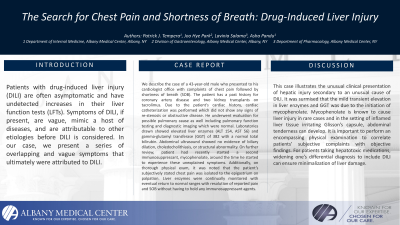Back


Poster Session D - Tuesday Morning
Category: Liver
D0570 - The Search for Chest Pain and Shortness of Breath: Drug-Induced Liver Injury
Tuesday, October 25, 2022
10:00 AM – 12:00 PM ET
Location: Crown Ballroom

Has Audio

Patrick J. Tempera, DO
Albany Medical College
Albany, NY
Presenting Author(s)
Patrick J. Tempera, DO1, Joo Hye Park, MD1, Lavinia Salama, PharmD2, Asha Pandu, MD1
1Albany Medical Center, Albany, NY; 2Albany College of Pharmacy and Health Sciences, Albany, NY
Introduction: Patients with drug-induced liver injury (DILI) are often asymptomatic and have undetected increases in their liver function tests (LFTs). Symptoms of DILI, if present, are vague, mimic a host of diseases, and are attributable to other etiologies before DILI is considered. In our case, we present a series of overlapping and vague symptoms that ultimately were attributed to DILI.
Case Description/Methods: We describe the case of a 43-year-old male who presented to his cardiologist office with complaints of chest pain followed by shortness of breath (SOB). The patient has a past history for coronary artery disease and two kidney transplants on tacrolimus. Due to the patient's cardiac history, cardiac catheterization was performed which did not show any signs of re-stenosis or obstructive disease. He underwent evaluation for possible pulmonary cause as well including pulmonary function testing and diagnostic imaging which were normal. Laboratories drawn showed elevated liver enzymes (ALT 154, AST 56) and gamma-glutamyl transferase (GGT) of 382 with a normal total bilirubin. Abdominal ultrasound showed no evidence of biliary dilation, choledocholithiasis, or structural abnormality. On further review, patient had recently started a second immunosuppressant, mycophenolate, around the time he started to experience these unexplained symptoms. Additionally, on thorough physical exam, it was noted that the patient’s subjectively stated chest pain was isolated to the epigastrium on palpation. Liver enzymes were continually monitored with eventual return to normal ranges with resolution of reported pain and SOB without having to hold any immunosuppressant agents.
Discussion: This case illustrates the unusual clinical presentation of hepatic injury secondary to an unusual cause of DILI. It was surmised that the mild transient elevation in liver enzymes and GGT was due to the initiation of mycophenolate. Mycophenolate is known to cause liver injury in rare cases and in the setting of inflamed liver tissue irritating Glisson’s capsule, abdominal tenderness can develop. It is important to perform an encompassing physical examination to correlate patients’ subjective complaints with objective findings. For patients taking hepatotoxic medications, widening one’s differential diagnosis to include DILI can ensure minimalization of liver damage.
Disclosures:
Patrick J. Tempera, DO1, Joo Hye Park, MD1, Lavinia Salama, PharmD2, Asha Pandu, MD1. D0570 - The Search for Chest Pain and Shortness of Breath: Drug-Induced Liver Injury, ACG 2022 Annual Scientific Meeting Abstracts. Charlotte, NC: American College of Gastroenterology.
1Albany Medical Center, Albany, NY; 2Albany College of Pharmacy and Health Sciences, Albany, NY
Introduction: Patients with drug-induced liver injury (DILI) are often asymptomatic and have undetected increases in their liver function tests (LFTs). Symptoms of DILI, if present, are vague, mimic a host of diseases, and are attributable to other etiologies before DILI is considered. In our case, we present a series of overlapping and vague symptoms that ultimately were attributed to DILI.
Case Description/Methods: We describe the case of a 43-year-old male who presented to his cardiologist office with complaints of chest pain followed by shortness of breath (SOB). The patient has a past history for coronary artery disease and two kidney transplants on tacrolimus. Due to the patient's cardiac history, cardiac catheterization was performed which did not show any signs of re-stenosis or obstructive disease. He underwent evaluation for possible pulmonary cause as well including pulmonary function testing and diagnostic imaging which were normal. Laboratories drawn showed elevated liver enzymes (ALT 154, AST 56) and gamma-glutamyl transferase (GGT) of 382 with a normal total bilirubin. Abdominal ultrasound showed no evidence of biliary dilation, choledocholithiasis, or structural abnormality. On further review, patient had recently started a second immunosuppressant, mycophenolate, around the time he started to experience these unexplained symptoms. Additionally, on thorough physical exam, it was noted that the patient’s subjectively stated chest pain was isolated to the epigastrium on palpation. Liver enzymes were continually monitored with eventual return to normal ranges with resolution of reported pain and SOB without having to hold any immunosuppressant agents.
Discussion: This case illustrates the unusual clinical presentation of hepatic injury secondary to an unusual cause of DILI. It was surmised that the mild transient elevation in liver enzymes and GGT was due to the initiation of mycophenolate. Mycophenolate is known to cause liver injury in rare cases and in the setting of inflamed liver tissue irritating Glisson’s capsule, abdominal tenderness can develop. It is important to perform an encompassing physical examination to correlate patients’ subjective complaints with objective findings. For patients taking hepatotoxic medications, widening one’s differential diagnosis to include DILI can ensure minimalization of liver damage.
Disclosures:
Patrick Tempera indicated no relevant financial relationships.
Joo Hye Park indicated no relevant financial relationships.
Lavinia Salama indicated no relevant financial relationships.
Asha Pandu indicated no relevant financial relationships.
Patrick J. Tempera, DO1, Joo Hye Park, MD1, Lavinia Salama, PharmD2, Asha Pandu, MD1. D0570 - The Search for Chest Pain and Shortness of Breath: Drug-Induced Liver Injury, ACG 2022 Annual Scientific Meeting Abstracts. Charlotte, NC: American College of Gastroenterology.
